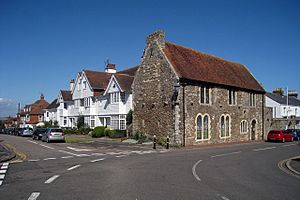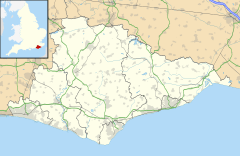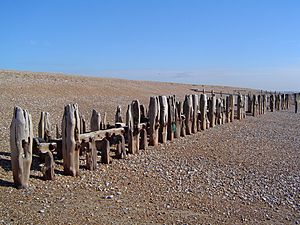Winchelsea facts for kids
Quick facts for kids Winchelsea |
|
|---|---|
 The Court Hall, High Street |
|
| Population | 600 |
| OS grid reference | TQ9017 |
| • London | 54 miles (87 km) NW |
| Civil parish |
|
| District |
|
| Shire county | |
| Region | |
| Country | England |
| Sovereign state | United Kingdom |
| Post town | WINCHELSEA |
| Postcode district | TN36 |
| Dialling code | 01797 |
| Police | Sussex |
| Fire | East Sussex |
| Ambulance | South East Coast |
| EU Parliament | South East England |
| UK Parliament | |
| Website | http://www.winchelsea.com |
Winchelsea (pronounced WIN-chel-see) is a small town in East Sussex, England. It is located between the High Weald area and the Romney Marsh. Winchelsea is about 2 miles (3.2 km) southwest of Rye and 7 miles (11 km) northeast of Hastings.
The town you see today was started in 1288. It replaced an older town, also called Winchelsea, which was lost to the sea. This happened because of coastal erosion and big floods in the late Middle Ages. Winchelsea is part of the larger civil parish of Icklesham.
The mayor of Winchelsea is chosen each year by a group called the corporation. These members are known as freemen. New freemen are also chosen by the existing members. This system is a leftover from when Winchelsea was a "rotten borough." This meant it could elect two Members of Parliament, but only a very small number of people could vote.
The corporation lost its official government powers in 1886. However, it was kept alive as a charity. This was done to keep Winchelsea as part of the Cinque Ports group. Today, the mayor and corporation mostly have a ceremonial role. They also help look after the town's old buildings and the Winchelsea Court Hall Museum.
Contents
What's in a Name?
The name Winchelsea might come from two old words. 'Qwent' was a local word for the marshland behind the town. 'Chesil' was a Saxon word meaning a shingle beach or a raised bank.
Winchelsea's Past
Old Winchelsea's Story
The original town of Old Winchelsea was built on a large bank of shingle. This bank protected the meeting point of three rivers: the Brede, Rother, and Tillingham. It also created a safe place for ships called the Camber. Records show the old town was called Winceleseia in 1130.
After the Norman Conquest (when the Normans took over England), Winchelsea became very important. It was a key place for trade across the English Channel. It also served as a naval base for ships. In the 1200s, it was well-known for trading wine from Gascony (a region in France).
It's thought that Old Winchelsea had over 700 houses, two churches, and more than 50 inns in the 1260s. This means thousands of people likely lived there. But the sea kept attacking the town. Before 1280, parts of it were destroyed. Then, a huge flood in 1287 completely wiped out the old town.
Building New Winchelsea
After the old town was lost, its people moved to the current location. In 1281, King Edward I gave permission for a new, planned town to be built. This new town was designed with a grid layout. It was built on higher ground, away from the sea. The new town kept the important title of "Ancient Town." It also stayed part of the Cinque Ports group, along with Rye.
The town had a tidal harbour on the River Brede. It did well until the mid-1300s. Then, it faced attacks from French and Spanish forces during the Hundred Years' War. The terrible Black Death also hit the town. In 1350, a sea battle called the Battle of Les Espagnols sur Mer happened nearby. In 1360, French soldiers attacked and burned the town.
Winchelsea remained a busy place, though it became smaller. Its good times ended in the 1520s when its harbour filled up with silt. Camber Castle was built by King Henry VIII in the early 1500s. It was placed between Winchelsea and Rye to protect the approach to the Camber. Many stones for the castle may have come from the nearby Franciscan monastery, Greyfriars.
Winchelsea was very involved in the wine trade with Guyenne (another French region). You can still visit the many wine cellars under the town on special open days. In the 1500s, a small group of Huguenots (French Protestants) also lived in Winchelsea.
Winchelsea still has its medieval feel. It sits on a hill surrounded by mostly empty marshland. You can still see the original plan of the town. It also has the largest collection of medieval wine cellars in England, apart from Norwich and Southampton. Three of the town's four original gates are still standing. Several old buildings remain, including the church dedicated to St Thomas the Martyr.
Another church, St Leonard's, later became the site of a windmill. This windmill was blown down in the Great Storm of 1987. You can still see parts of the old 13th and 14th-century walls at the Strand Gate and Pipewell or Ferry Gate. The "New Gate" is over half a mile outside the current town. This shows how big the original plan for New Winchelsea was.
Across from the churchyard is the Court Hall. This is one of Winchelsea's oldest buildings. The ground floor used to be a gaol (jail). The top floor is now a museum. It holds many items from Winchelsea's history. Nearby is the town well, dug in 1851. It is thought to be 80 feet (24 m) deep.
At the bottom of Strand Hill is Strand House. This building was once the town's workhouse. It was built around 1425. This area also has the remains of other old buildings, like the Old Malt House. In 2013, archaeologists found parts of a medieval wharf and a medieval boat here.
Winchelsea is located on the main south coast road, the A259. The Royal Military Canal passes by the east side of the town. This canal was built in the early 1800s to defend against a possible invasion by Napoleon Bonaparte. It connects to the River Brede.
The town also gives its name to the nearby seaside village of Winchelsea Beach.
How Winchelsea is Governed
In 2006, some local people asked the Rother District Council to look at how Icklesham parish was set up. They wanted to create a separate Winchelsea Parish. A group called the Parish of Winchelsea Action Group collected signatures from 228 voters who supported the idea.
Other surveys showed that most Winchelsea residents wanted a separate parish. However, most people in the rest of Icklesham parish were against it. In the May 2007 parish council elections, the idea of a separate parish council was the main topic. The three candidates who supported a separate parish for Winchelsea won by a clear majority.
Getting Around Winchelsea
Winchelsea railway station is about 0.75 miles (1.21 km) north of the town. It is on the Marshlink line, which runs between Ashford International and Hastings.
The A259 road, a main road from Hastings to Folkestone, goes around the edge of the village. Stagecoach Group runs a bus service from Hastings to Rye that stops in Winchelsea.
Famous People from Winchelsea
- Vera Atkins (1908–2000), a leader in a special operations group during World War II, lived in Winchelsea after the war.
- Joseph Conrad (1857–1924), a famous writer, lived for a time in a farmhouse called 'The Pent'.
- Ford Madox Ford (1873–1939), another writer, moved to Winchelsea in 1901.
- Henry Irving (1838–1905), a well-known actor, lived in a summer house in Winchelsea from 1892.
- John Harris (c. 1666–1719), an author and editor, was the rector (church leader) of Winchelsea.
- Rod Hull (1935–1999), a puppeteer, lived and died in Winchelsea.
- Spike Milligan (1918–2002), a comedian, writer, and actor, lived near Winchelsea. He is buried in the churchyard of St Thomas's.
- Maud Peel (1844-1939), an artist.
- Eric Slater (1896–1963), an artist and printmaker, lived in Winchelsea.
- Sir Melford Stevenson (1902–1987), a lawyer and High Court Judge, lived in Winchelsea from 1953 to 1987. His ashes are buried in the churchyard.
- Ellen Terry (1847–1928), an actress, bought and lived in a summer house called Tower Cottage in Winchelsea starting in 1892.
- W.M. Thackeray (1811-1863), a novelist, lived in Winchelsea for a time. He set his unfinished novel Denis Duval there.
Images for kids
See also
 In Spanish: Winchelsea para niños
In Spanish: Winchelsea para niños









